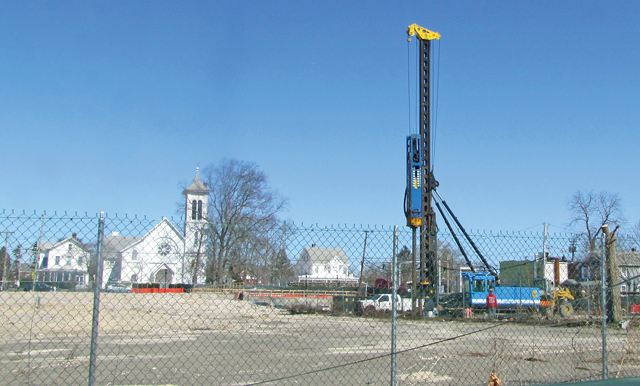Developer says pile driving didn’t harm church


Representatives of the Riverview Lofts apartments, now under construction on East Main Street, say tests of the vibration levels generated by pile driving at the site are not responsible for cracks detected in three century-old buildings across the street.
And they have an engineering report to back that up.
This comes in response to a recent report from an engineer hired by Riverhead United Methodist Church, one of the purportedly affected buildings. That report, according to an April 3 letter to the Riverhead building department, said the 1869 church and its adjacent parsonage, built around 1970, had sustained structural damage since the pile driving work began in early March.
“Continued vibrations can cause the shifting and dislodging of the foundation’s stones, jeopardizing the structural integrity of the building foundation,” said the letter from H2M Architects and Engineers.
Also sustaining damage, according to owner Arlene Doroszka, is her 1902 home, located immediately east of the church.
All three structures are located within a historic district recognized by the National Register of Historic Places. All three also now have vibration detectors installed to measure the effect of pile driving work at the development site.
David Gallo, president of Georgica Greens Ventures, developer of the 116-unit apartment project, said in an interview last week that he requested an independent review of the vibrations as well as the data generated by vibration monitors placed in the three historic buildings and found nothing that would have caused any damage.
That report, from J.R. Holzmacher PE, LLC, of Ronkonkoma, was prepared for Georgica Greens in response to the April 3 letter from H2M.
The two engineering studies have conflicting results.
The H2M report on the church building had stated: “Vibrations from the pile operations are causing the leveling support sands of the foundation wall to migrate and shift out of the wall,” the H2M letter stated. “Additionally, many areas throughout the church and parsonage building are showing signs of movement as observed by numerous cracks in the walls and ceiling,” it added.
H2M had asked the town building department to order the pile driving work stopped.
The engineering report from Holzmacher stated that they had reviewed current photographs of the structural damage cited by the H2M letter and found that “the cracks identified in the photographs are not indicative of recent settlement. Many of the cracks are smooth and some even containing multiple patched attempts. This indicates that settlement in the existing structure has been occurring over a long period of time, prior to the construction activities taking place [across the street].”
Jonathan Brown, the attorney for the church, said he has not received a copy of the Holzmacher report. He said his clients maintain that the damage has worsened since pile driving work began.
Brad Hammond, Riverhead Town’s senior building inspector, said the vibration monitors are in the basements at the church and Ms. Doroszka’s house, and on the west side of the foundation of the parsonage.
If vibrations reach a level considered to be dangerous, he explained, the monitors will go off and notify both the building department and the developers. The town receives daily reports from the vibration sensors.
Originally, the monitors were set to go off at 0.5 inches per second, Mr. Hammond said. That was later lowered to 0.3 inches per second, he said.
However, none of the readings to date has topped 0.1 inches per second.
This result was also cited in the Holz-macher report, which cited readings from April 9 at all three sites. Work at the construction site is allowed to run from 8 a.m. to 5 p.m. But the vibration monitors record from 6:30 a.m. to 6:30 p.m., and often show readings from times when no work is being done, Mr. Hammond said. These off-hours readings can reflect vibrations from other sources, like traffic, he said.
“It’s probably too much of a coincidence to assume that [the construction] had nothing to do with it,” Mr. Hammond said of the damage. “But our daily vibration reports show that nothing significant has been happening.”
“We are obviously very concerned as well,” Mr. Gallo said. “But there has been nothing that would demonstrate that we’re doing anything wrong.”
Should a vibration monitor go off, he added, “within minutes we would know and the work would stop. I’m not like a horrible evil person. I’m looking to create affordable housing in the downtown. I don’t want to do damage to any church.”
Approximately 550 steel piles are expected to be driven into the ground over an eight-month period, according to environmental impact study for the project, submitted to the town by the developer.
“The installation of piles should not be problematic to the neighborhood with respect to noise or vibration,” the EIS stated.
The pilings are required in order to build on a AE flood zone, such as this area, in order to stabilize the ground, according to Mr. Hammond.
He said the building plans that were approved for the project have not been changed since work began.
Mr. Hammond said he’s noticed cracks in paint and plaster within the buildings, but doesn’t believe there’s been any structural damage.
“It’s on my radar and we’re paying close attention to it,” Mr. Hammond said. “We don’t take it lightly.”
If the vibration monitors hit the threshold number, he said, “we will stop the job.”
Photo caption: Large pile drivers used at the site of the Riverview Lofts apartments in downtown Riverhead have caused damage to the nearby Riverhead Methodist Church. (Credit: Tim Gannon)





